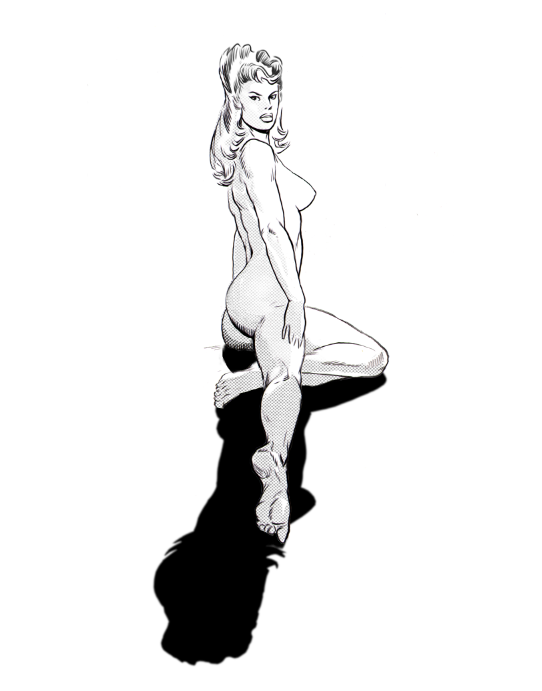When you are drawing shadows, there are a couple of rules which need to be remembered in order to create a natural looking illusion of light. Fortunately, Andrew Loomis helps us negotiate these points in his book Successful Drawing.
The first rule he indicates is an observation regarding the two location choices of light source when representing cast shadows; that is, a behind light source or a before light source. Behind and before are designations of where the light source is in relation to the viewer of the picture, not the subject. Examine these samples I’ve drawn for you below.
In the picture of the Ogre below, the primary cast shadow on the ground plane shows us that the light source is behind you– the viewer of this picture. The ogre’s actual body is interrupting the direction the light is falling, and hence, it casts a shadow behind. Notice that cast shadows which are even somewhat to the side of the subject are still considered the result of a behind light source.
If the light source is behind, the shadow will fall behind.
(NB. In this drawing there happens to be two light sources, as you can see in the secondary small cast shadow under the ogre’s chin, and likewise below his hands. For this matter, we are regarding only the large cast shadow on the ground.)

This drawing is considered to be a light source which is before the viewer. One can tell on account of the fact that the shadow is falling between where we the viewers are, and the subject matter of the lady, as she sits on the plane. One can imagine the sun above her, in the sky, before where you are standing, looking at this lady. The sun before you, therefore constitutes a before light source.
If the light source is before, the shadow will fall between.
Now that the terms before and behind have been established, there are several rules about casting shadows from before and behind light. Here are Loomis’ rules about drawing cast shadows.
- If the light source is behind the viewer, the angle of the light comes from below the horizon.
- If the light source is before the viewer, the angle of light comes from above the horizon.
- If the light source is before the viewer, put the shadow VP on the horizon nearby, below the light source.
- When the light source is before the viewer, the angle of light is the nearest of the 3 cast shadow considerations;
- position of light source
- angle of light
- VP of shadow on the horizon
- All shadows radiate from a point on the ground directly below the light source. This point is the shadow vanishing point (SVP)
- All shadows within a drawing recede to the same SVP.
- The length of shadow on the ground plane is determined by the angle of light.
That is a lot to digest, so at this point, it may be of use to my readers to think on these concepts for a while, before diving into how one actually draws before and behind light source shadows. Next week, I will demonstrate that process, as well as how to cast shadows of organic shapes, like those in my samples above.
Thank you very much for your continued interest.
Bye for now.